Influence of Rubber Size on Properties of Crumb Rubber Mortars
Abstract
:1. Introduction
2. Experimental Program
2.1. Materials and Mixture Proportions
2.2. Specimen Preparation and Test Methods
3. Results and Discussion
3.1. Properties of Fresh Mortars
3.2. Porosity Structures of Hardened Rubberized Mortars
3.3. Mechanical Properties of CRM
3.4. Drying Shrinkage and Mass Loss
3.4.1. Drying Shrinkage Results
3.4.2. Mass Loss Results
3.4.3. Discussion
4. Conclusions
Author Contributions
Conflicts of Interest
References
- Hunag, L.-J.; Wang, H.-Y.; Wang, S.-Y. A study of the durability of recycled green building materials in lightweight aggregate concrete. Constr. Build. Mater. 2015, 96, 353–359. [Google Scholar] [CrossRef]
- Pelisser, F.; Zavarise, N.; Longo, T.A.; Bernardin, A.M. Concrete made with recycled tire rubber: Effect of alkaline activation and silica fume addition. J. Clean. Prod. 2011, 19, 757–763. [Google Scholar] [CrossRef]
- Khaloo, A.R.; Dehestani, M.; Rahmatabadi, P. Mechanical properties of concrete containing a high volume of tire-rubber particles. Waste Manag. 2008, 28, 2472–2482. [Google Scholar] [CrossRef] [PubMed]
- Yung, W.H.; Yung, L.C.; Hua, L.H. A study of the durability properties of waste tire rubber applied to self-compacting concrete. Constr. Build. Mater. 2013, 41, 665–672. [Google Scholar] [CrossRef]
- Hao, R.X.; Dong, S.F.; Guo, X.Y. The Research of Scrap Tire Rubber Powder Effect on the Performance of Cracking Mortar. Adv. Mater. Res. 2012, 472–475, 1777–1781. [Google Scholar] [CrossRef]
- Lv, J.; Zhou, T.; Du, Q.; Wu, H. Effects of rubber particles on mechanical properties of lightweight aggregate concrete. Constr. Build. Mater. 2015, 91, 145–149. [Google Scholar] [CrossRef]
- Siddique, R.; Naik, T.R. Properties of concrete containing scrap-tire rubber—An overview. Waste Manag. 2004, 24, 563–569. [Google Scholar] [CrossRef] [PubMed]
- Hernández-Olivares, F.; Barluenga, G.; Parga-Landa, B.; Bollati, M.; Witoszek, B. Fatigue behaviour of recycled tyre rubber-filled concrete and its implications in the design of rigid pavements. Constr. Build. Mater. 2007, 21, 1918–1927. [Google Scholar] [CrossRef]
- Liu, F.; Meng, L.Y.; Ning, G.F.; Li, L.J. Fatigue performance of rubber-modified recycled aggregate concrete (RRAC) for pavement. Constr. Build. Mater. 2015, 95, 207–217. [Google Scholar] [CrossRef]
- Han, Q.; Wang, Y.; Xu, J.; Xing, Y. Static behavior of stud shear connectors in elastic concrete–steel composite beams. J. Constr. Steel Res. 2015, 113, 115–126. [Google Scholar] [CrossRef]
- Han, Q.H.; Xu, J.; Xing, Y.; Li, Z.L. Static push-out test on steel and recycled tire rubber-filled concrete composite beams. Steel Comp. Struct. 2015, 19, 843–860. [Google Scholar] [CrossRef]
- Xue, J.; Shinozuka, M. Rubberized concrete: A green structural material with enhanced energy-dissipation capability. Constr. Build. Mater. 2013, 42, 196–204. [Google Scholar] [CrossRef]
- Aiello, M.A.; Leuzzi, F. Waste tyre rubberized concrete: Properties at fresh and hardened state. Waste Manag. 2010, 30, 1696–1704. [Google Scholar] [CrossRef] [PubMed]
- De Raghavan, H.H.; Ferraris, C. F. Workability, mechanical properties, and chemical stability of a recycled tyre rubber-filled cementitious composite. J. Mater. Sci. 1998, 33, 1745–1752. [Google Scholar] [CrossRef]
- Aziz, F.N.A.A.; Bida, S.M.; Nasir, N.A.M.; Jaafar, M.S. Mechanical properties of lightweight mortar modified with oil palm fruit fibre and tire crumb. Constr. Build. Mater. 2014, 73, 544–550. [Google Scholar] [CrossRef]
- Topcu, I.B. The Properties of Rubberized Concretes. Cem. Concr. Res. 1995, 25, 304–310. [Google Scholar] [CrossRef]
- Khatib, Z.K.; Bayomy, F.M. Rubberized Portland Cement Concrete. J. Mater. Civ. Eng. 1999, 11, 206–213. [Google Scholar] [CrossRef]
- Fattuhi, N.I.; Clark, L.A. Cement-based materials containing shredded scrap truck tyre rubber. Constr. Build. Mater. 1996, 10, 229–236. [Google Scholar] [CrossRef]
- Khan, M.N.A. Cementitious composites containing recycled tire rubber: An overview of engineering properties and potential applications. Cem. Concr. Aggreg. 2001, 23, 3–9. [Google Scholar]
- Su, H.; Yang, J.; Ling, T.C.; Ghataora, G.S.; Dirar, S. Properties of concrete prepared with waste tyre rubber particles of uniform and varying sizes. J. Clean. Prod. 2015, 91, 288–296. [Google Scholar] [CrossRef]
- Pacheco-Torgal, F.; Ding, Y.; Jalali, S. Properties and durability of concrete containing polymeric wastes (tyre rubber and polyethylene terephthalate bottles): An overview. Constr. Build. Mater. 2012, 30, 714–724. [Google Scholar] [CrossRef]
- Azevedo, F.; Pacheco-Torgal, F.; Jesus, C.; de Aguiar, J.B.; Camões, A.F. Properties and durability of HPC with tyre rubber wastes. Constr. Build. Mater. 2012, 34, 186–191. [Google Scholar] [CrossRef]
- Flores-Medina, D.; Flores Medina, N.; Hernández-Olivares, F. Static mechanical properties of waste rests of recycled rubber and high quality recycled rubber from crumbed tyres used as aggregate in dry consistency concretes. Mater. Struct. 2013, 47, 1185–1193. [Google Scholar] [CrossRef]
- Thomas, B.S.; Gupta, R.C. Long term behaviour of cement concrete containing discarded tire rubber. J. Clean. Prod. 2015, 102, 78–87. [Google Scholar] [CrossRef]
- Yang, R.; Li, K. Effect of rubber particles on cement stabilized gravel system. J. Wuhan Univ. Technol. 2014, 29, 990–995. [Google Scholar] [CrossRef]
- Angelin, A.F.; Andrade, M.F.; Bonatti, R.; Lintz, R.C.C.; Gachet-Barbosa, L.A.; Osório, W.R. Effects of spheroid and fiber-like waste-tire rubbers on interrelation of strength-to-porosity in rubberized cement and mortars. Constr. Build. Mater. 2015, 95, 525–536. [Google Scholar] [CrossRef]
- Kang, J.F.; Han, C.C.; Zhang, Z.L. Strength and shrinkage behaviors of roller-compacted concrete with rubber additives. Mater. Struct. 2008, 42, 1117–1124. [Google Scholar]
- Turatsinze, A.; Bonnet, S.; Granju, J.L. Potential of rubber aggregates to modify properties of cement based-mortars: Improvement in cracking shrinkage resistance. Constr. Build. Mater. 2007, 21, 176–181. [Google Scholar] [CrossRef]
- Bravo, M.; de Brito, J. Concrete made with used tyre aggregate: Durability-related performance. J. Clean. Prod. 2012, 25, 42–50. [Google Scholar] [CrossRef]
- Huang, X.; Ranade, R.; Ni, W.; Li, V.C. On the use of recycled tire rubber to develop low E-modulus ECC for durable concrete repairs. Constr. Build. Mater. 2013, 46, 134–141. [Google Scholar] [CrossRef]
- Standard for Test Method of Performance on Building Mortar Construction Ministry of China; JGJ/T70-2009; China Association for Standardization: Beijing, China, 2009.
- Chen, X.; Wu, S.; Zhou, J. Pore size distribution of cement mortar prepared with crushed limestone sand. J. Civ. Eng. 2015, 20, 762–767. [Google Scholar] [CrossRef]
- Guo, Y.; Wang, X.; Qian, J. Physical model of drying shrinkage of recycled aggregate concrete. J. Wuhan Univ. Technol. 2015, 30, 1260–1267. [Google Scholar] [CrossRef]
- Mohammed, B.S.; Awang, A.B.; Wong, S.; Nhavene, C.P. Properties of nano silica modified rubbercrete. J. Clean. Prod. 2016, 119, 66–75. [Google Scholar] [CrossRef]
- Method of Testing Cements-Determination of Strength; GB/T17671-1999; China Association for Standardization: Beijing, China, 1999.
- Standard for Test Method of Performance on Building Mortar; JGJ70-1990; China Association for Standardization: Beijing, China, 1990.
- Sukontasukkul, P.; Tiamlom, K. Expansion under water and drying shrinkage of rubberized concrete mixed with crumb rubber with different size. Constr. Build. Mater. 2012, 29, 520–526. [Google Scholar] [CrossRef]
- Chen, H.J.; Huang, S.S.; Tang, C.W.; Malek, M.A.; Ean, L.W. Effect of curing environments on strength, porosity and chloride ingress resistance of blast furnace slag cement concretes: A construction site study. Constr. Build. Mater. 2012, 35, 1063–1070. [Google Scholar] [CrossRef]
- Poon, C.S.; Kou, S.C.; Lam, L. Compressive strength, chloride diffusivity and pore structure of high performance metakaolin and silica fume concrete. Constr. Build. Mater. 2006, 20, 858–865. [Google Scholar] [CrossRef]
- Oliveira, M.J.; Ribeiro, A.B.; Branco, F.G. Curing effect in the shrinkage of a lower strength self-compacting concrete. Constr. Build. Mater. 2015, 93, 1206–1215. [Google Scholar] [CrossRef]
- Zhang, W.; Hama, Y.; Na, S.H. Drying shrinkage and microstructure characteristics of mortar incorporating ground granulated blast furnace slag and shrinkage reducing admixture. Constr. Build. Mater. 2015, 93, 267–277. [Google Scholar] [CrossRef]
- Shen, W.; Li, X.; Gan, G.; Cao, L.; Li, C.; Bai, J. Experimental investigation on shrinkage and water desorption of the paste in high performance concrete. Constr. Build. Mater. 2016, 114, 618–624. [Google Scholar] [CrossRef]
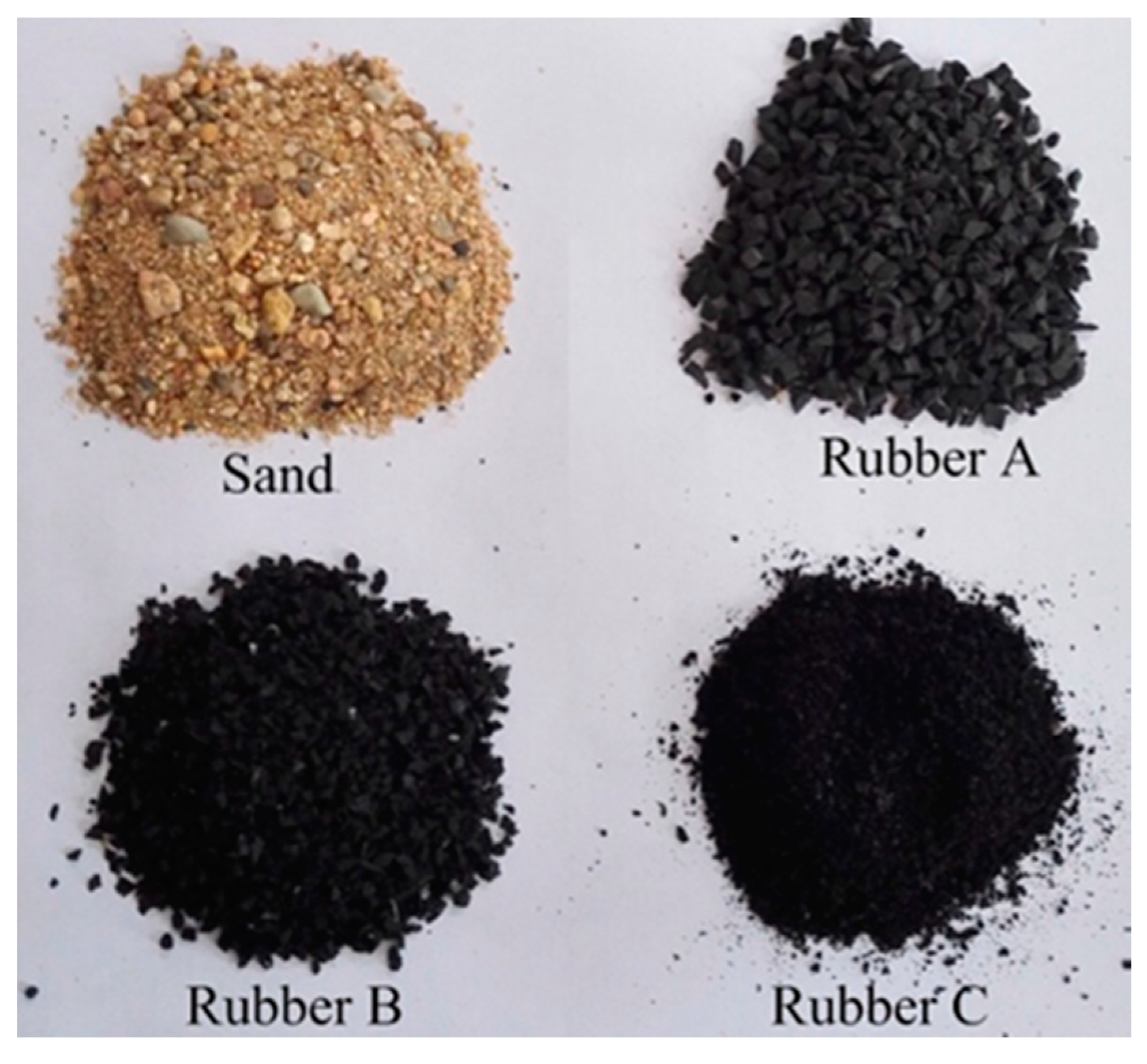
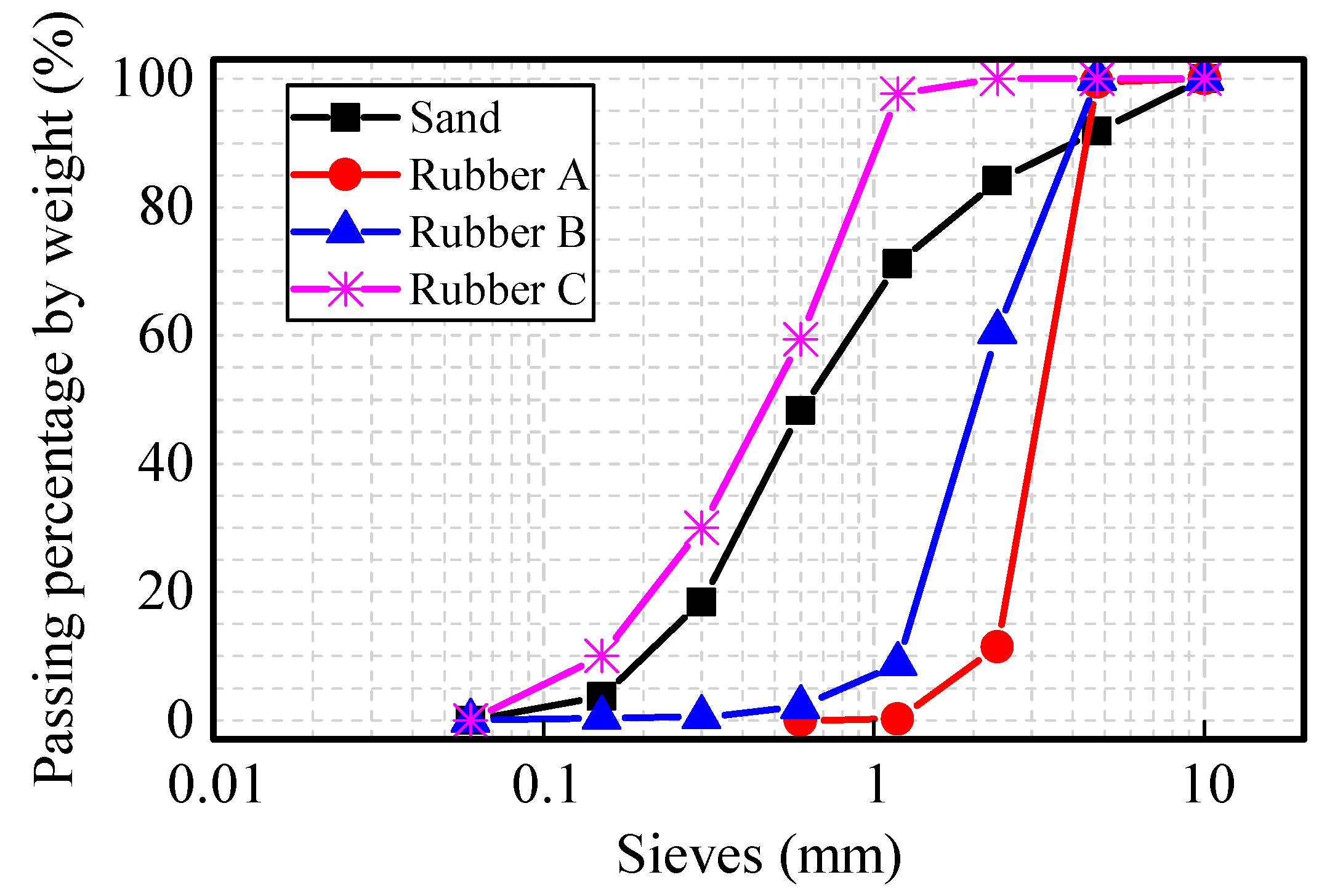


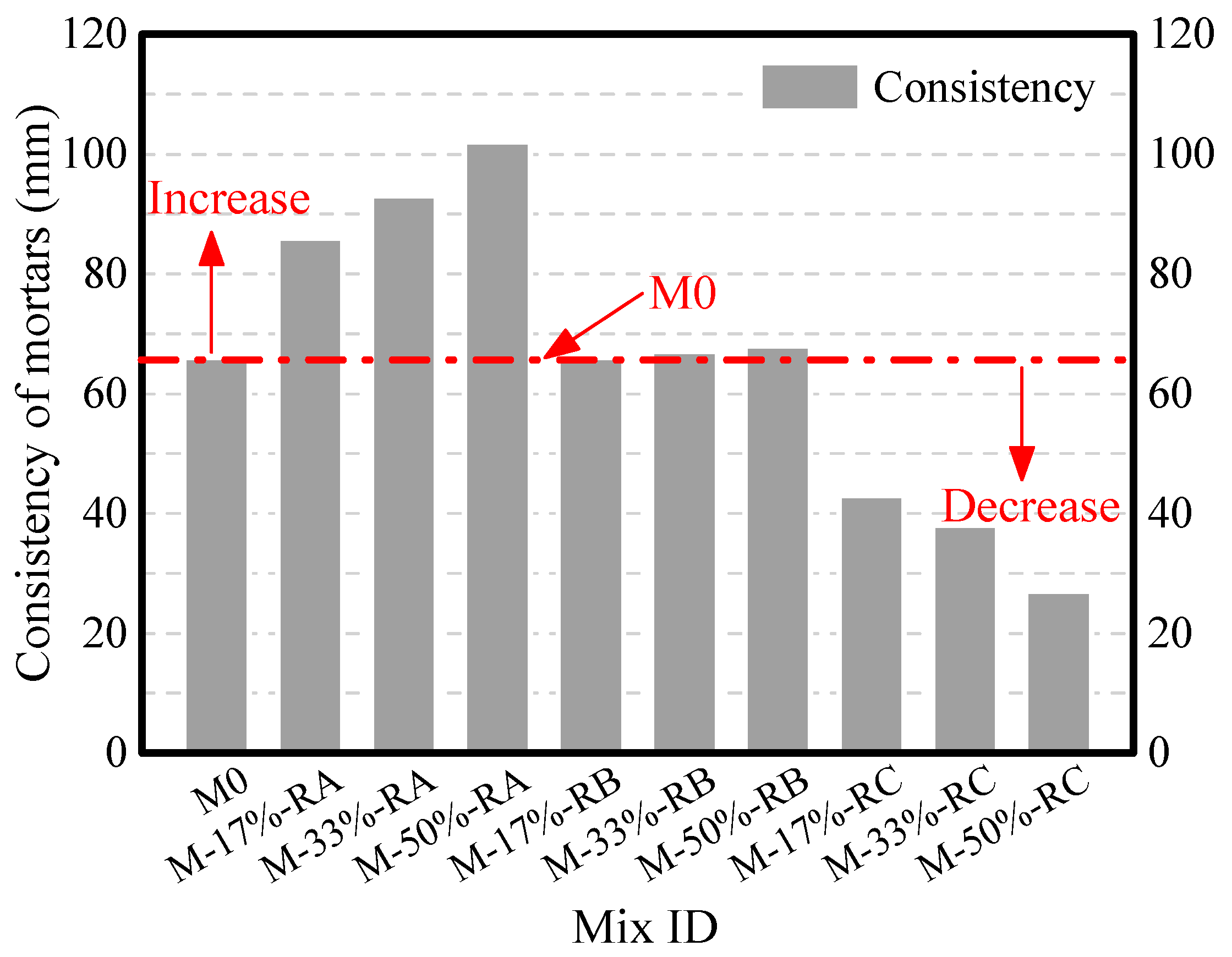
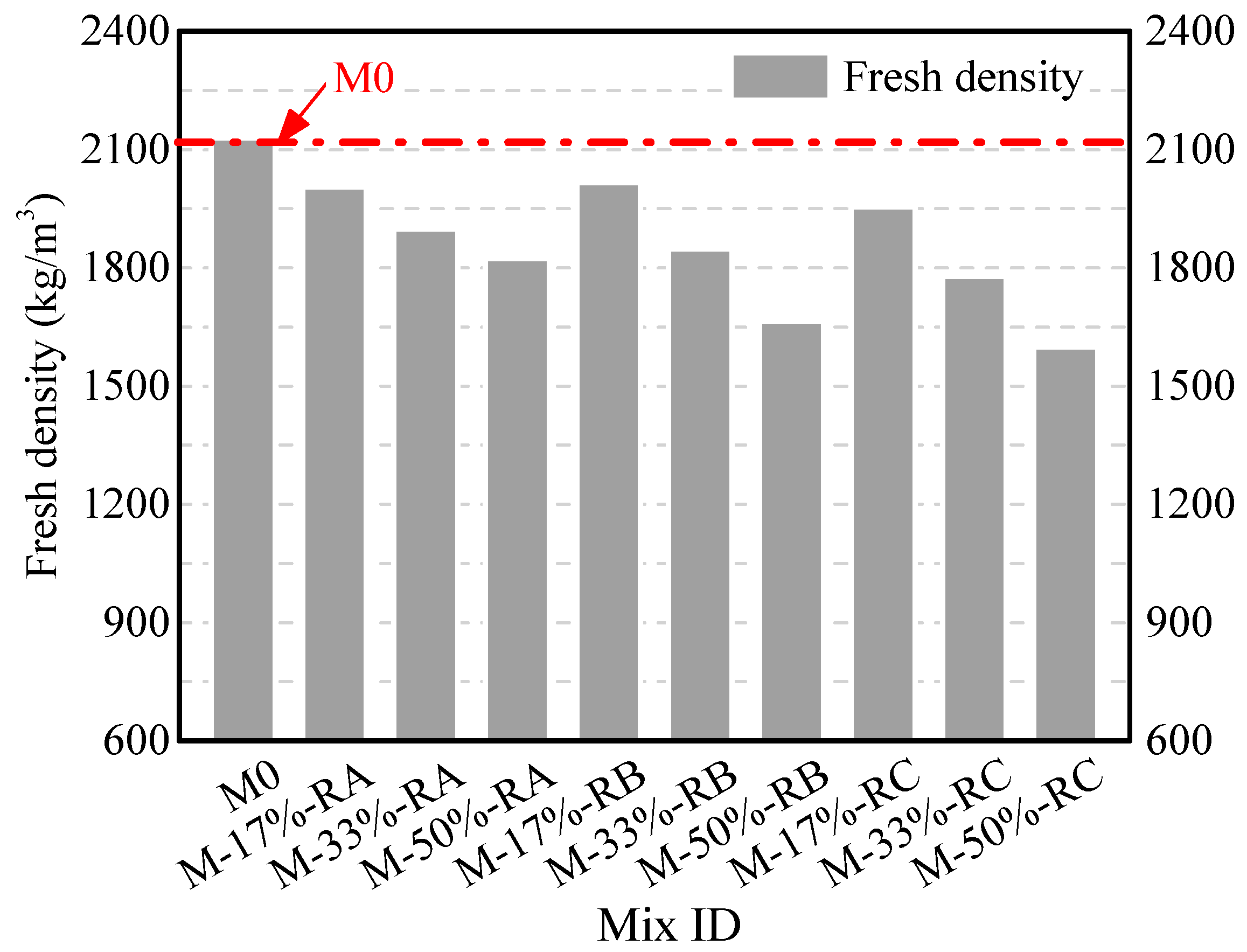
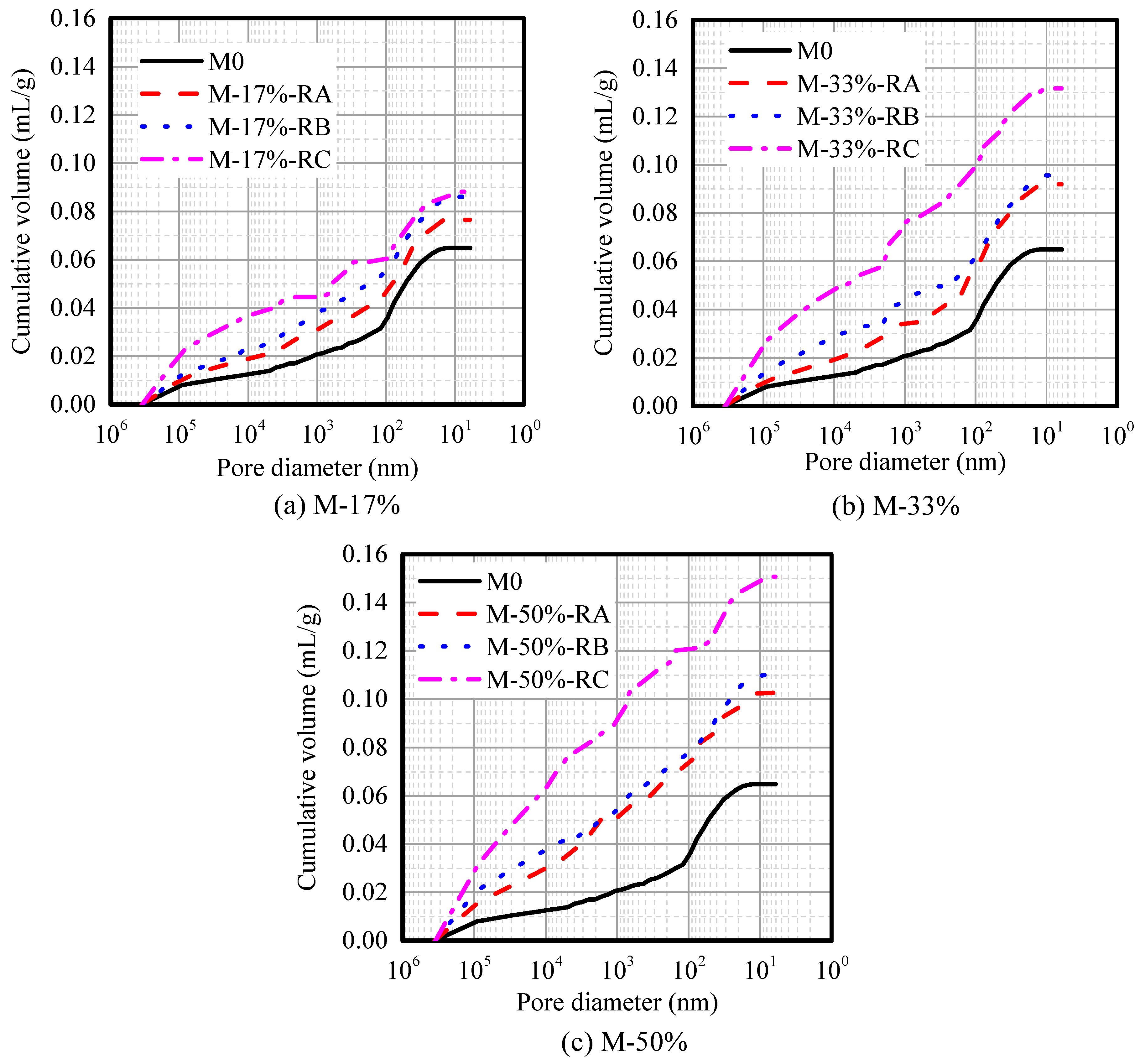
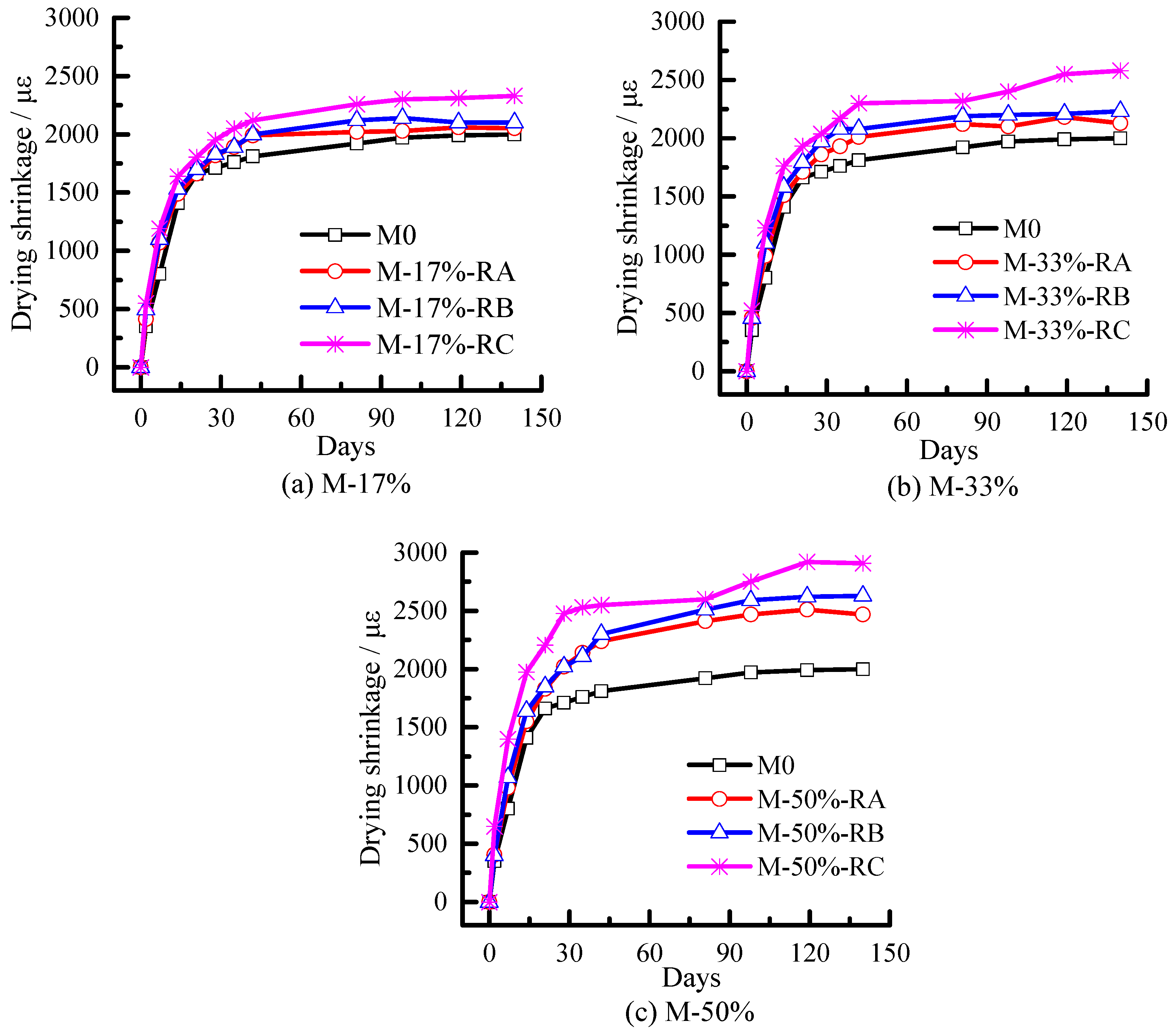
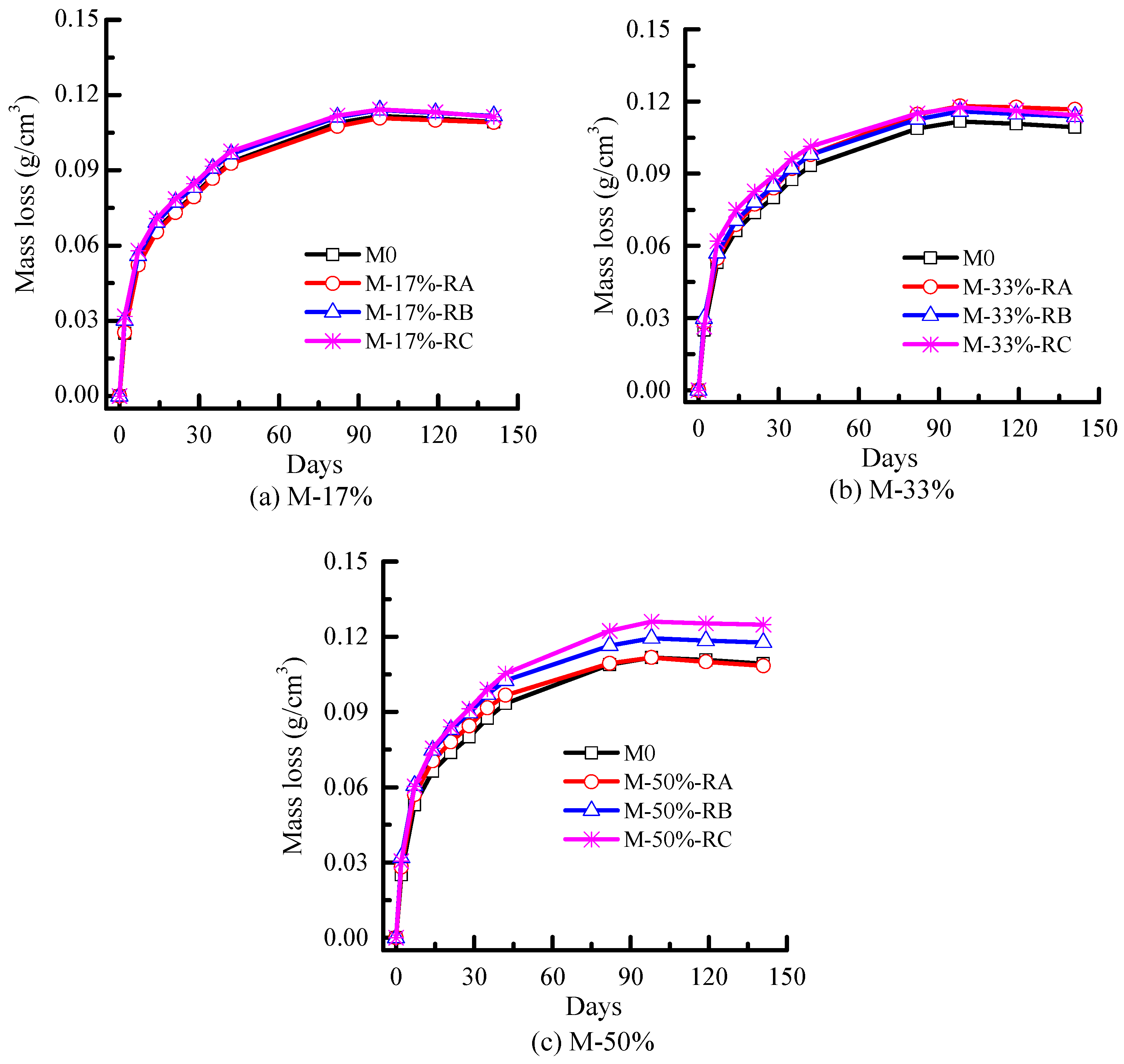
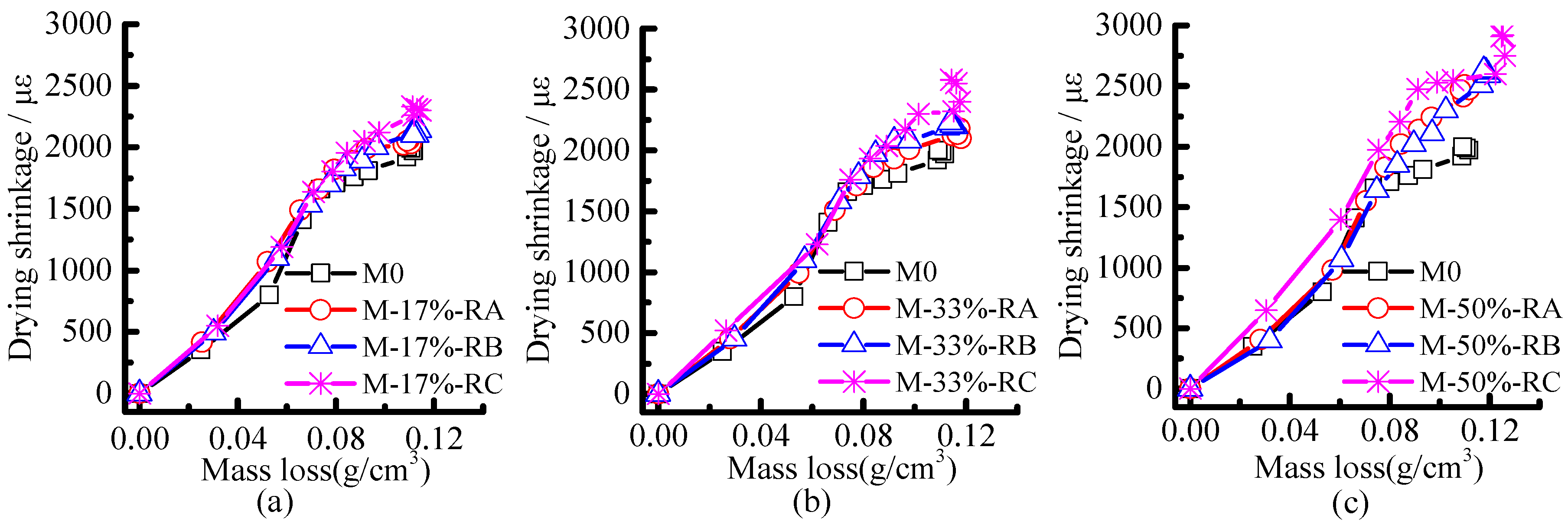
| Chemical Compound | CaO | SiO2 | Al2O3 | Fe2O3 | SO3 | MgO | Lgnition Loss |
|---|---|---|---|---|---|---|---|
| Percentage (%) | 63.11 | 22.60 | 5.03 | 4.38 | 2.24 | 1.46 | 1.18 |
| Rubber Hydrocarbon | Carbon Black | Acetone Extract | Isoprene | Water | Ash Content | Fiber Content | Metal Content | Others |
|---|---|---|---|---|---|---|---|---|
| 45.2 | 25.8 | 14.2 | 12.1 | 0.8 | 0.9 | 0.5 | 0.08 | 0.42 |
| Mix | Water | Cement | Sand | Rubber (A/B/C) |
|---|---|---|---|---|
| M0 | 0.50 | 1 | 2.50 | 0 |
| M-17% | 0.50 | 1 | 2.08 | 0.17 |
| M-33% | 0.50 | 1 | 1.68 | 0.33 |
| M-50% | 0.50 | 1 | 1.25 | 0.50 |
| Sample | Pore Volume (mL/g) | |
|---|---|---|
| Total Pore Volume | Mesopore (<50 nm) Volume | |
| M0 | 0.0650 | 0.0139 |
| M-17%-RA | 0.0765 | 0.0168 |
| M-33%-RA | 0.0919 | 0.0186 |
| M-50%-RA | 0.1026 | 0.0191 |
| M-17%-RB | 0.0861 | 0.0171 |
| M-33%-RB | 0.0956 | 0.0196 |
| M-50%-RB | 0.110 | 0.0224 |
| M-17%-RC | 0.0881 | 0.0151 |
| M-33%-RC | 0.1316 | 0.0200 |
| M-50%-RC | 0.1506 | 0.0267 |
| Sample | Compressive Strength/MPa | Flexural Strength/MPa | Splitting Strength/MPa | Elastic Modulus/GPa |
|---|---|---|---|---|
| M0 | 49.2 | 7.4 | 3.7 | 25.2 |
| M-17%-RA | 35.7 | 6.3 | 2.7 | 21.2 |
| M-33%-RA | 27.4 | 5.3 | 1.9 | 17.5 |
| M-50%-RA | 11.7 | 3.5 | 1.5 | 14.8 |
| M-17%-RB | 37.2 | 6.1 | 2.2 | 20.3 |
| M-33%-RB | 24.3 | 4.9 | 1.7 | 16.0 |
| M-50%-RB | 12.5 | 3.3 | 1.3 | 13.1 |
| M-17%-RC | 28.5 | 5.6 | 2.0 | 18.2 |
| M-33%-RC | 19.4 | 4.3 | 1.4 | 14.9 |
| M-50%-RC | 10.9 | 3.1 | 1.1 | 11.9 |
© 2016 by the authors; licensee MDPI, Basel, Switzerland. This article is an open access article distributed under the terms and conditions of the Creative Commons Attribution (CC-BY) license (http://creativecommons.org/licenses/by/4.0/).
Share and Cite
Yu, Y.; Zhu, H. Influence of Rubber Size on Properties of Crumb Rubber Mortars. Materials 2016, 9, 527. https://doi.org/10.3390/ma9070527
Yu Y, Zhu H. Influence of Rubber Size on Properties of Crumb Rubber Mortars. Materials. 2016; 9(7):527. https://doi.org/10.3390/ma9070527
Chicago/Turabian StyleYu, Yong, and Han Zhu. 2016. "Influence of Rubber Size on Properties of Crumb Rubber Mortars" Materials 9, no. 7: 527. https://doi.org/10.3390/ma9070527
APA StyleYu, Y., & Zhu, H. (2016). Influence of Rubber Size on Properties of Crumb Rubber Mortars. Materials, 9(7), 527. https://doi.org/10.3390/ma9070527






